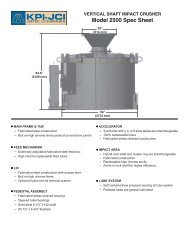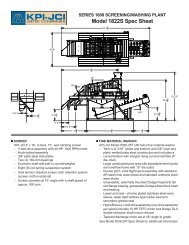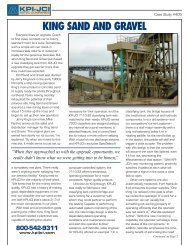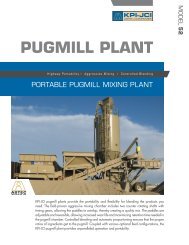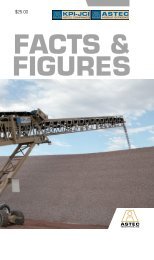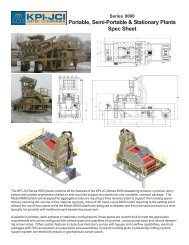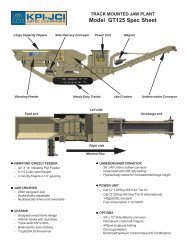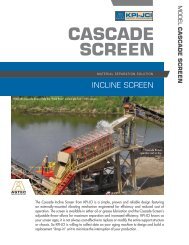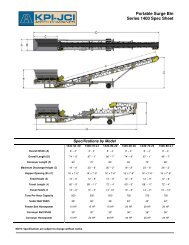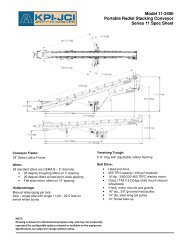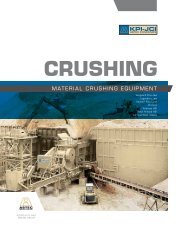Download Today's Aggregate and Mining Solutions - Vol 3 ... - KPI-JCI
Download Today's Aggregate and Mining Solutions - Vol 3 ... - KPI-JCI
Download Today's Aggregate and Mining Solutions - Vol 3 ... - KPI-JCI
- No tags were found...
Create successful ePaper yourself
Turn your PDF publications into a flip-book with our unique Google optimized e-Paper software.
• A mechanical pick mounted to a boom that is either fixedin length or telescopic is the first of the tools used to replace aman with a pry bar. Mechanical pick efficiency is limited bythe fact it basically is a scraping tool that must be forced intonatural crevices/faults <strong>and</strong> then levered down. That is why itis more effective in sedimentary rock due to the natural faults.This action can cause lifting <strong>and</strong> dropping of the engine endwhen the loose material releases that causes maintenanceissues with axles <strong>and</strong> oscillating components, not to mention theaffect on the operator. The hydraulic strength required for thisoperation is transferred through the boom <strong>and</strong> carrier as thereis no effective way to cushion the affects. The pick tends to getjammed on a regular basis adding time to the process. This tooldoes not allow for shaping of the corners which is important tostrengthen the back to the side walls.• Hydraulic breakers for scaling can provide a higherproduction rate or add to bigger problems for the minedepending on the options available for the unit. The hydraulicbreaker must be adjusted to the material type it is to work withto avoid over scaling. This will require the reduction in thehydraulic breakers energy at the working tool to prevent overscaling. The approach angle of the breaker to the surface to bescaled should be considered, which should be approximatelya 30-degree angle. Any greater upward angle will have theunit doing production work not scaling. It is also advisableto have the breaker equipped for anti-blank firing, which isimportant when the tool jams in a crevice. Without anti-blankit will continue to fire, damaging the retainer pins <strong>and</strong> tool.The breaker should have a cushion chamber that reduces thevibration to the boom <strong>and</strong> carrier reducing maintenance costs<strong>and</strong> lost time. A bigger issue with breakers is that during thescaling operation contaminants work their way into the breakeras the tool end is exposed to the contaminants, naturally theyend up in the hydraulic system. There is very little that can bedone to stop this. A donut made from conveyor belting couldbe fit over the tool close to the bottom of the breaker. It is onlyeffective if it remains in place. A tighter lip seal around thepiston of the breaker will delay the effects of the contaminants.Underst<strong>and</strong>ing GeologicalStructure VariationsScaling is the removal of unsecure material from the back, sidewalls,<strong>and</strong> face. Making the drift/tunnel safe for the next operation is themain purpose in scaling. How that is done varies throughout the world,along with different geological formations, which does have an affecton scaling efficiency <strong>and</strong> safety especially after blasting—particularlywhere there is rock deformation <strong>and</strong> damage within the fragmentationenvelope.The following descriptions were taken from a <strong>Mining</strong> worksheet for theEngineering Programme at Concordia University:• Igneous Rocks are crystalline solidswhich form directly from the cooling ofmagma. Igneous rocks are given namesbased on what they are made of, ortheir composition <strong>and</strong> the size of thecrystals <strong>and</strong>/or texture of the rock. Asan example basalt <strong>and</strong> granite are igneous rock. The solid mass ofigneous rock creates the greatest amount of problem for scaling dueto the jointing variables found in the rock.• Sedimentary Rocks are calledsecondary because they are often theresult of the accumulation of smallpieces broken off of pre-existingrocks. The sedimentary rock covers theigneous rock in most parts of the world.Examples of sedimentary rock are s<strong>and</strong>stone, limestone, <strong>and</strong> shale.Within the sedimentary you have three types: Clastic, Chemical, <strong>and</strong>Organic.• Metamorphic Rock gets its name from“meta” (change) <strong>and</strong> “morph” (form).Any rock can become metamorphic bychanging its environment such that itsstability <strong>and</strong> equilibrium is affected.This rock form can also have a negativeaffect on the scaling operation.The type of jointing common to solid rock masses may vary; a paperby Paavo Harkko on scaling principles describes the four major jointsbelow.• Cubic jointing – the joints extend inthree directions almost perpendicular toeach other <strong>and</strong> each with roughly thesame joint frequency.• Slab jointing – the joint intervalin one joint direction is denser thanin the others, giving an appearancethat is often similar to that found insedimentary rocks.• Wedge jointing – two or more jointdirections are better developed thanothers; at least two tend to cut atdifferent angles forming wedge shapedsections.Hydraulic breakers for scaling whether conventional or hammer-feed can provide a higherproduction rate, but it’s important to protect with anti-blank firing <strong>and</strong> ideally a separatehydraulic circuit with a gear pump to minimize contamination experienced at the tool end.• Mixed jointing – the joints areusually not linear <strong>and</strong> lead in differentdirections without any particulardirection prevailing.Today’s aggregate & mining solutions | volume 3, number 1 15



